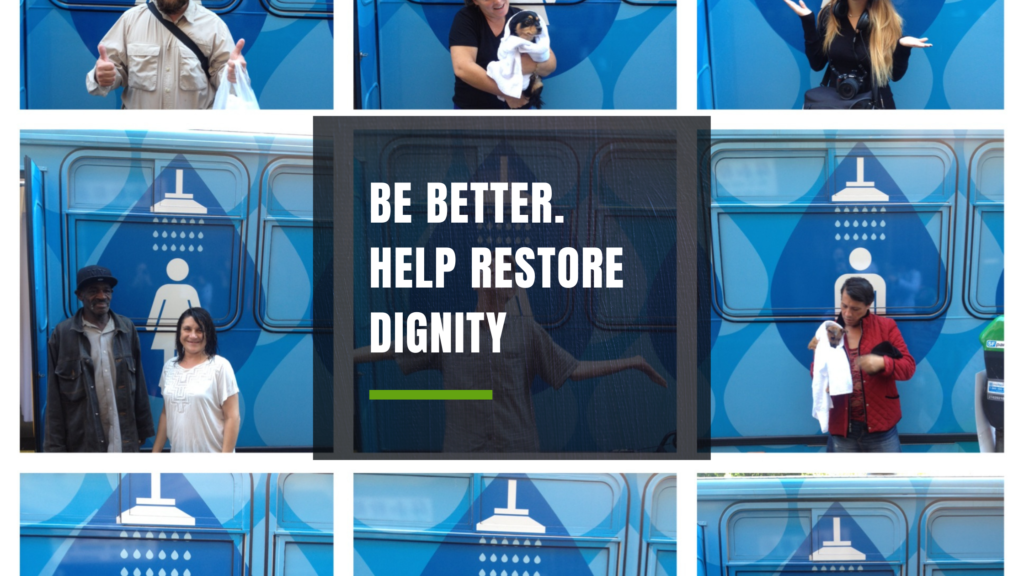by Sylvie Manaigre
Have you ever spent a night outdoors? Like REALLY outdoors? I’m talking no shelter, no money, no gear. Just you, Mother Nature, and whatever random abandoned human-made materials you can gather…
Due to poor trip planning, I spent 1 night in a tent, on the ground, in just an emergency blanket. After only hours in the REAL outdoors, I was without question, the smelliest I have ever been. My lack of proper clothing caused me to shiver while my anxiety triggered my fight or flight response, resulting in cold sweats throughout the night. To put it lightly, my clothes reeked of musty bodily fluids. The dehydration from the combination of my physical exercise and night sweats caused my breath to be horrid. I couldn’t stand the smell of myself. I was beyond unpleasant.
That was 1 night outdoors. 1 night. I felt as though everyone I passed in the trails could smell me and was judging me. I couldn’t wait to get to the hotel, drink some water, take a hot shower, put on some clean, cozy pajamas, and order a hot pizza that I could eat in bed, under some warm clean sheets. That’s exactly what I did, and it was glorious.
Unfortunately, about 20% (1.6 Billion) of the world population doesn’t have access to those luxuries. I say ‘luxuries’ but I really mean ‘necessities’. Pizza specifically isn’t essential, but you know what I mean. Clean water, food, and shelter shouldn’t be considered symbols of great comfort and extravagant living, they are essentials to human health.
Locally (Toronto):
- 18.5% of Toronto households experience food insecurity
- 10,000+ homeless people are sleeping outdoors, in shelters, in emergency respite centres, and in health and correctional facilities every night (This doesn’t even begin to reflect the true number of people without an address that live in the GTA and the province of Ontario).
- 98% occupancy rate in Toronto shelters every night
- 75% experiencing homelessness struggle with mental illness
- 333,060 people are on the subsidized housing waitlist
- 36% of homeless people have been homeless for more than one year
- 8.5 years the average wait for a 2-bedroom apartment
- 29% of the homeless population are aged 51 or older
Nationally (Canada):
- 35,000 Canadians are homeless on any given night.
- 27% are women
- 19% are youth
- 28-34% are Indigenous. (Indigenous people are overrepresented amongst the homeless population in virtually all urban centres in Canada).
- The number of adults 55+ years old experiencing homelessness is rising—a combined 24% of shelter users.
- In addition to the visibly homeless, 450,000 – 900,000 Canadians represent the ‘hidden’ homeless.
Globally
The United Nations Human Settlements Program estimates that roughly 20% of the world’s population (1.6 billion) people live in inadequate housing, and the best data available suggest that ~150 million people have no housing at all.
Why It’s difficult to get an accurate picture of local, national, and global homelessness?
Homelessness describes the situation of an individual, family or community without stable, safe, permanent, appropriate housing, or the immediate prospect, means and ability of acquiring it.
‘Hidden Homeless’: Many cities have chosen to criminalize homelessness. While some homeless might choose to be incarcerated over living in the streets (for warmth, food, shelter, and access to medical care), many choose to hide and retain their ‘freedom’.
An analysis conducted by Dr. Brendan O’Flaherty, a professor of economics at Columbia University, projects an increase in homelessness by 40-45% this year over January 2019.
Causes of homelessness across countries are multifaceted, though some factors stand out, including:
- Shortages of affordable housing
- Privatization of civic services
- Unplanned and rapid urbanization
- Poverty
- Unemployment
- Family breakdowns
Also contributing is a lack of services and facilities for those suffering from mental illness, alcoholism or substance abuse and displacement caused by conflicts, natural disasters and government housing policies.
The effects of homelessness
In some cases, too, homelessness leads to alcoholism, substance abuse and mental illness.
Homelessness is costly for cities and taxpayers. The average monthly costs of shelter beds are $1,932, almost ten times higher than the average monthly cost of social housing of $199.92. In addition, homeless people and those poorly housed have a higher rate of illness. The monthly cost of a hospital bed is $10,900. The State of Homelessness reports that the annual cost of homelessness to the Canadian economy is $7.05 billion dollars.
I went down a feel good philanthropy rabbit hole. I am happy to report that I am not the first person to think of trying to create access to hot showers for the homeless. There are many organizations on a local, national and global scale that provide hygiene services to the homeless. The media loves to sensationalize the negative, but there are so many good people serving others who never get the spotlight. I reached out to many organizations, and one that really impressed me with their global impact and ‘Radical Hospitality’ was Lava Mae.
LAVA MAE PROGRESS & IMPACT
- 32,354+ GUESTS SERVED
- 78,101+ SHOWERS PROVIDED
- 170+ COMMUNITIES INSPIRED
- 131+ PROGRAMS ADVISED
- 12+ COUNTRIES REACHED
- 43+ POP UP CARE VILLAGES
Over 2,000 people have now downloaded the Lava Mae tool kit, which talks through the details of how to launch and run this type of service, including how to choose a vehicle and location, how to deal with local regulations, and the organization’s philosophy of “radical hospitality,” an approach that treats the people using the service with dignity and respect
About LavaMaeX: LavaMaex is a nonprofit accelerator that’s building a worldwide network of providers who take critical services to the street, where the unhoused need them most. With an approach rooted in Radical Hospitality®—meeting people, wherever they are, with extraordinary care—LavaMaex is changing the way the world sees and serves our unhoused neighbors, and helps restore dignity, rekindle optimism and fuel a sense of opportunity for people experiencing homelessness

A note from the CEO
The CEO Kris Kleper contacted us to let us know:
“Your contribution will help fund our programs. We are currently distributing hygiene kits (have distributed 7,000 since March)…”
- About 20% of what we do is direct service to stay connected to those on the streets.
- 70% of our time is spent consulting/advising/creating tools for partners who want to bring our programs to the streets of their community (mobile hygiene and handwashing stations).
- We also spend about 10% of our time in innovation – testing/trying new products or programs that fit within our mission based on what we’re hearing/seeing on the streets.
Imagine you haven’t showered in weeks. You don’t have a bed to lay on or a new change of underwear or socks. People won’t sit next to you on the bus, or even look you in the eye. What would that feel like?
This is a daily reality for our neighbors moving through homelessness, and we’re on a mission to help communities build mobile showers, DIY handwashing stations, and Pop-Up Care Villages to rekindle dignity, restore optimism, and unlock opportunity.
Will you join us?
CLICK TO READ ABOUT OUR LIVE KINSTRETCH – OR SIGN UP FOR ‘MOVE FOR THE BETTER GOOD’!
References:
- http://www.nationalhomeless.org/factsheets/addiction.pdf
- https://www.acto.ca/production/wp-content/uploads/2017/07/Factsheet-4-Homelessness-in-Canada-and-Ontario2.pdf
- https://community.solutions/analysis-on-unemployment-projects-40-45-increase-in-homelessness-this-year/
- https://homelesshub.ca/about-homelessness/topics/mental-health
- https://futurism.com/1-6-billion-people-lack-adequate-housing-heres-how-we-can-fix-this
- https://ighomelessness.org/about-us/
- https://www.fredvictor.org/facts-about-homelessness-in-toronto/
- https://www.theglobeandmail.com/news/national/canada-experiencing-alarming-growth-in-child-homelessness/article28756629/

